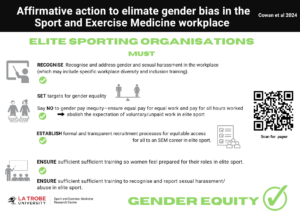For full study, click here!
Why is this study important?
The under-representation of women in sports leadership is a significant problem worldwide, that reflects gender inequity, enables gender harassment and discrimination and undermines the participation and aspiration of women and girls in the sports domain.
Worldwide women sport and exercise medicine (SEM) physicians perceive significantly more disrespectful attitudes, have their judgement questioned and are sexually harassed more than their men counterparts [1]. In Australia, while gender inequality and harassment for women SEM practitioners is perceived we actually know little about their experiences.
How did the study go about this?
We surveyed all titled Australian Physiotherapy Association Sport and Exercise Physiotherapists, SEM Physicians, Registrars, doctors and physiotherapists (SEM practitioners) currently/previously/aspiring to work in Australian elite sport. The survey included a bespoke online survey and the Gender Experiences Questionnaire. The bespoke online survey included questions about demographics, sporting teams worked with, recruitment and workplaces experiences. The Gender Experiences Questionnaire was used to assess gender harassment for SEM practitioners in their workplace.
What did the study find?
Consistent with other workplaces, women SEM practitioners (both current and previous) working in elite sport in Australia experience significantly more workplace gender inequality and harassment than men.
Workplace characteristics
Women working in elite sport are paid for less hours per week and less weeks per year than men. Whilst men and women contributed a similar amount of unpaid hours each week (about 5) as women worked less paid hours per week, approximately 27% of their working hours were unpaid compared to only 13 % of mens.
Our survey results indicate that men practitioners were more likely to work with men athletes, reflecting their dominance in Australian SEM roles that have been considered more prestigious and well-paid. Men’s sport in Australia receives significantly more media coverage [2], has a higher public profiles and is better paid than women’s sport [3] [4] [5] [6] [7]. This points to a likely gender pay gap for women working in elite sport in Australia, in fact our research indicated that men may have been paid more than double the amount that women were paid for their work in elite sport.
Gender harassment
The results from the Gender Experiences questionnaire indicate that women physiotherapists experience more gender-based harassment, infantilisation, and work-family policing than men. Examples of gender harassment include using derogatory terms of address, comments about women being ill-suited for management, sexist jokes and crude behaviour [8]. Such harassment may significantly impact their professional growth and opportunities.
What are the key take-home points?
Working in elite sport as a woman SEM practitioner in Australia is challenging with women more likely to experience gender based harassment at work. Women SEM practitioners are also more likely to work with women athletes, which may make them vulnerable to lower renumeration and leadership recognition
Affirmative action is needed to eliminate gender bias in the SEM workplace (Figure 1). There is a growing need for elite sports organisations to establish transparent recruitment processes, enforce gender equality targets, and eliminate gender pay gaps.

References
- Tsukahara, Y., et al., Gender bias in sports medicine: an international assessment of sports medicine physicians’ perceptions of their interactions with athletes, coaches, athletic trainers and other physicians. Br J Sports Med, 2022. 56(17): p. 961-969.
- Chalkley-Rhoden, S. Decline of women’s sports coverage in Australia ‘a tragedy’ 2015; Available from: https://www.abc.net.au/news/2015-04-12/decline-of-women-sports-coverage-in-australia-a-tragedy/6359786.
- Agency, W.G.E., Data explorer:sports and recreation activities within Arts and Recreation Services Division. 2019.
- Parry, K. How the sports world is still stacked against top women. 2022 30/1/2024]; Available from: https://theconversation.com/how-the-sports-world-is-still-stacked-against-top-women-175462.
- Misener, L. and E. Pearson. Hockey canada must stop treating womens and para hockey like an afterthought. 2022; Available from: https://theconversation.com/hockey-canada-must-stop-treating-womens-and-para-hockey-like-an-afterthought-192327.
- Foundation, W.S. The fight for equal pay in womens sports. 2019 [cited 2023 Jan 30 ]; Available from: https://www.womenssportsfoundation.org/education/fight-equal-pay-womens-sports/.
- Financy. Highest paid female athletes earn less than top male athlete. Financy 2023; https://financy.com.au/highest-paid-female-athletes-earn-less-than-top-male-athlete/#:~:text=The%20gender%20pay%20gap%20in,a%20good%20year%20for%20women.&text=The%20world’s%20ten%20highest%2Dpaid,face%20significant%20gender%20pay%20disparities.]. Available from: https://financy.com.au/highest-paid-female-athletes-earn-less-than-top-male-athlete/#:~:text=The%20gender%20pay%20gap%20in,a%20good%20year%20for%20women.&text=The%20world’s%20ten%20highest%2Dpaid,face%20significant%20gender%20pay%20disparities.
- Leskinen, E. and L. Cortina, Dimensions of Disrespect: Mapping and Measuring Gender Harassment in Organizations. . Psychology of Women Quarterly., 2014. 38(1): p. 107-123